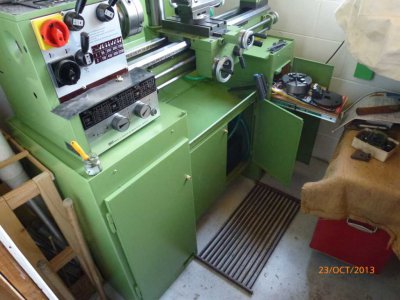- Joined
- Feb 24, 2015
- Messages
- 1,382
My new PM01127-VF-LB lathe is due to arrive pretty soon — maybe a few weeks. This thread will be about my preparations, set-up and general experience with this new tool.
Anyone else with a PM1127 feel free to share observations, questions or whatever. I'd like this to be a good general discussion area for that machine.
Preparations have been in planning for the last 8 weeks. Today, I think I've finalized plans for the stand. It will be a HF heavy duty 42" base tool cabinet with a welded custom wheel trolly system to lower the overall height about 4" lower than the standard wheels the cabinet comes equipped with. The tool chest is a substantial cabinet, very heavy duty and rated for about 3,000 pounds.
The top of the stand will be 2 layers of 3/4" Baltic Birch plywood with an additional piece to set the top in the recess on top of the cabinet.
Feedback is welcome.
All the steel on the trolly system will be 1/4" hot roll flats. I've devised wheel trucks for the left side that start with 3" iron wheels, bored and centered for a .5" bolt axle. The wheels are mounted on a truck that will pivot at the center on .5" bolt welded to the end part of the cabinet support. .5" leveling bolts are just inboard of the wheels for leveling the left side. I'm a little concerned that the .5" welded pivot bolt might not be enough. I'd love some feedback on that.
Here's an isometric drawing to demonstrate the concept. I didn't draw an isometric of the casters because it would a lot of effort that would serve no useful purpose.

This is a plan drawing showing the scale and overall details. Elevation view on top and plan view on the bottom. The truck is exploded off the base for clarity. The drawing left of that is the whole end assembly.
On the bottom the assembly view is a elevation view from the side.
The tool cabinet will rest on 1" x 1/8" steel angle spot welded to the rim of the stand.

The right and steerable side of the trolly will utilize leveling casters rated at 1100 pounds each. The brackets are .25" steel and gusseted inside.
This is my second area of concern, that the .25" steel will be up to the task of supporting the chest full of iron and lathe. I estimate that the total weight of the stand and lathe will around 1,000 pounds.
Below is a photo of the casters.

Anyone else with a PM1127 feel free to share observations, questions or whatever. I'd like this to be a good general discussion area for that machine.
Preparations have been in planning for the last 8 weeks. Today, I think I've finalized plans for the stand. It will be a HF heavy duty 42" base tool cabinet with a welded custom wheel trolly system to lower the overall height about 4" lower than the standard wheels the cabinet comes equipped with. The tool chest is a substantial cabinet, very heavy duty and rated for about 3,000 pounds.
The top of the stand will be 2 layers of 3/4" Baltic Birch plywood with an additional piece to set the top in the recess on top of the cabinet.
Feedback is welcome.
All the steel on the trolly system will be 1/4" hot roll flats. I've devised wheel trucks for the left side that start with 3" iron wheels, bored and centered for a .5" bolt axle. The wheels are mounted on a truck that will pivot at the center on .5" bolt welded to the end part of the cabinet support. .5" leveling bolts are just inboard of the wheels for leveling the left side. I'm a little concerned that the .5" welded pivot bolt might not be enough. I'd love some feedback on that.
Here's an isometric drawing to demonstrate the concept. I didn't draw an isometric of the casters because it would a lot of effort that would serve no useful purpose.
This is a plan drawing showing the scale and overall details. Elevation view on top and plan view on the bottom. The truck is exploded off the base for clarity. The drawing left of that is the whole end assembly.
On the bottom the assembly view is a elevation view from the side.
The tool cabinet will rest on 1" x 1/8" steel angle spot welded to the rim of the stand.
The right and steerable side of the trolly will utilize leveling casters rated at 1100 pounds each. The brackets are .25" steel and gusseted inside.
This is my second area of concern, that the .25" steel will be up to the task of supporting the chest full of iron and lathe. I estimate that the total weight of the stand and lathe will around 1,000 pounds.
Below is a photo of the casters.
Last edited:


